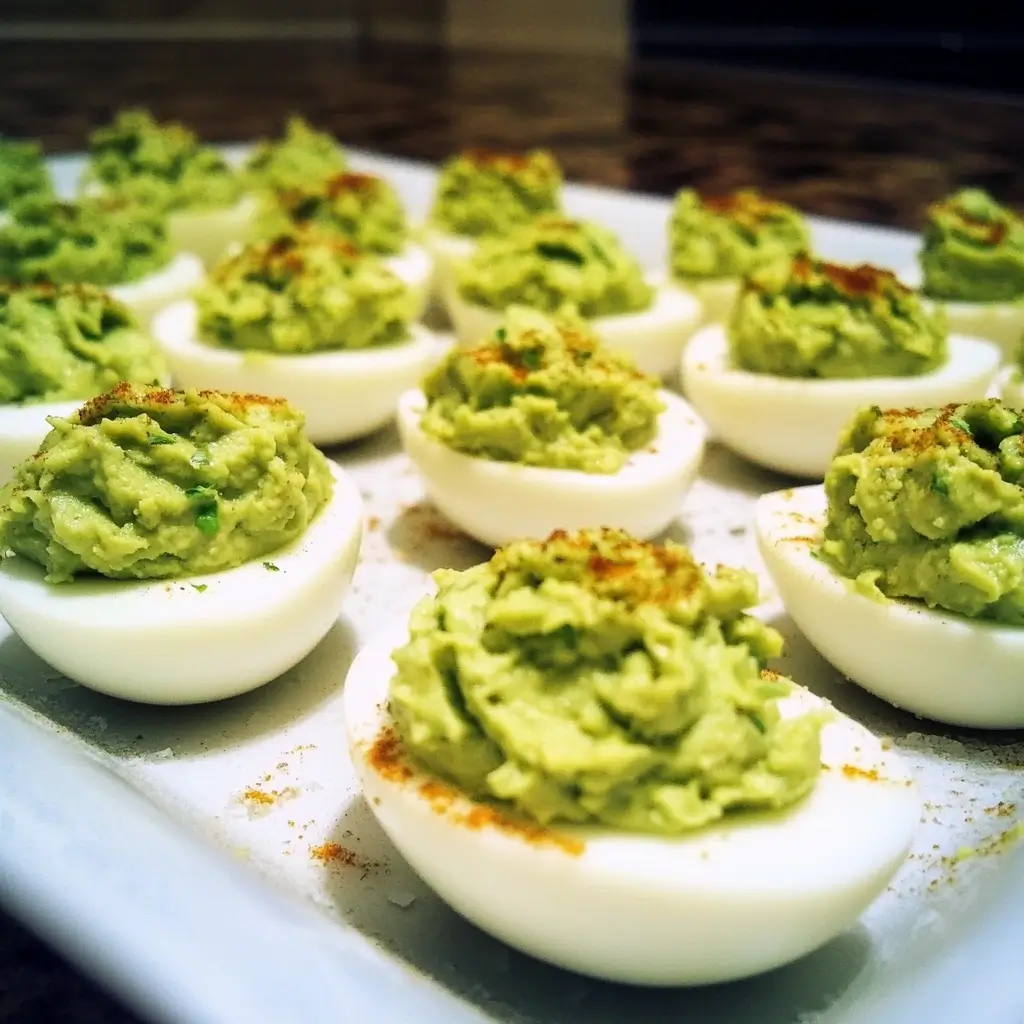Let me tell you, these Avocado Deviled Eggs have become an absolute sensation in my household and a star attraction at every gathering I host. For years, classic deviled eggs were a staple, but I always found myself wanting a little more – perhaps a healthier fat, a creamier texture, or just a fresh, modern twist. The moment I decided to swap out most of the mayonnaise for ripe, luscious avocado, it was a game-changer. The vibrant green hue is instantly appealing, hinting at the fresh, subtly grassy, and incredibly creamy filling within. My kids, who can be notoriously picky, devour these with gusto, often not even realizing they’re packed with the goodness of avocado. My friends constantly ask for the recipe, impressed by how such a simple ingredient swap can elevate a classic appetizer to new heights. They are, without a doubt, the perfect blend of familiar comfort and exciting innovation, making them a delicious and surprisingly healthy treat that disappears almost as quickly as I can make them. If you’re looking for an appetizer that’s guaranteed to impress, offers a healthier profile, and is bursting with flavor, you’ve absolutely come to the right place. These Avocado Deviled Eggs are your new go-to.
Ingredients
- 6 Large Eggs: The foundation of any great deviled egg, providing the perfect vessel for our creamy filling.
- 1 Large Ripe Avocado: The star of the show, choose one that yields gently to pressure for optimal creaminess and flavor.
- 2 Tablespoons Mayonnaise (optional, or Greek yogurt): Adds a touch of traditional deviled egg tang and richness; can be adjusted or substituted with Greek yogurt for an even healthier version.
- 1 Tablespoon Lime or Lemon Juice: Essential for preventing the avocado from browning and adding a bright, zesty kick that complements the richness.
- 1/4 Teaspoon Garlic Powder: Imparts a subtle, savory depth to the filling.
- 1/4 Teaspoon Onion Powder: Adds another layer of savory flavor that pairs beautifully with avocado.
- Salt, to taste: Enhances all the flavors; start with 1/4 teaspoon and adjust as needed.
- Freshly Ground Black Pepper, to taste: Adds a gentle warmth and complexity.
- Optional Garnishes: Smoked paprika, finely chopped cilantro, thinly sliced jalapeño, crumbled cooked bacon, or a sprinkle of everything bagel seasoning for added flair and flavor.
Instructions
- Hard-Boil the Eggs: Place the eggs in a single layer in a saucepan and cover with cold water by at least one inch. Bring the water to a rolling boil over high heat. Once boiling, immediately remove the pan from the heat, cover it, and let the eggs sit for 10-12 minutes for perfectly cooked yolks.
- Cool the Eggs: After 10-12 minutes, carefully drain the hot water and transfer the eggs to an ice bath (a bowl filled with ice and cold water). Let them cool completely for at least 10-15 minutes. This stops the cooking process and makes them easier to peel.
- Peel and Halve the Eggs: Once cooled, gently tap each egg on a hard surface and carefully peel away the shell. Rinse under cold water to remove any small shell fragments. Pat the eggs dry with a paper towel. Slice each egg in half lengthwise.
- Prepare the Filling: Gently scoop out the cooked yolks into a medium-sized mixing bowl. Place the egg white halves on a serving platter or a clean work surface.
- Mash the Yolks: Using a fork, mash the egg yolks until they are fine and crumbly.
- Add Avocado and Other Ingredients: Halve the ripe avocado, remove the pit, and scoop the flesh into the bowl with the mashed yolks. Immediately add the lime or lemon juice to prevent browning. Add the mayonnaise (or Greek yogurt, if using), garlic powder, onion powder, salt, and pepper.
- Combine and Mix: Mash everything together thoroughly with the fork until the mixture is smooth and creamy. For an extra-smooth filling, you can use a hand mixer on low speed or a small food processor, but be careful not to over-mix. Taste and adjust seasonings if necessary – you might want a little more salt, pepper, or lime juice.
- Fill the Egg Whites: You can fill the egg white halves in one of two ways:
- Spoon Method: Simply spoon the avocado-yolk mixture evenly into the cavities of the egg white halves.
- Piping Method (for a fancier look): Transfer the filling to a piping bag fitted with a star tip (or any decorative tip you prefer). If you don’t have a piping bag, you can use a zip-top plastic bag with a small corner snipped off. Pipe the filling generously into each egg white half.
- Garnish and Chill: Sprinkle your chosen garnishes over the filled deviled eggs. Popular choices include a dusting of smoked paprika for color, a sprinkle of fresh cilantro for brightness, or a thin slice of jalapeño for a little heat.
- Chill (Recommended): Cover the avocado deviled eggs loosely with plastic wrap (try not to let it touch the filling directly) and refrigerate for at least 30 minutes before serving. This allows the flavors to meld and the eggs to chill nicely. Serve cold.
Nutrition Facts
- Servings: 12 deviled egg halves (assuming 1 serving = 1 half)
- Calories per serving (approximate): 70-85 calories per half (depending on avocado size and mayo usage)
- Healthy Fats: Rich in monounsaturated fats from the avocado, which are heart-healthy and contribute to satiety.
- Protein: A good source of high-quality protein from the eggs, essential for muscle repair and overall body function.
- Fiber: Avocado adds a decent amount of dietary fiber, aiding in digestion and promoting a feeling of fullness.
- Vitamin K: Avocados are a good source of Vitamin K, important for blood clotting and bone health.
- Folate: Both eggs and avocados provide folate, crucial for cell growth and metabolism.
Preparation Time
- Total Preparation Time: Approximately 30-40 minutes.
- Active Time: About 20-25 minutes (peeling, mashing, mixing, filling).
- Inactive Time: About 10-15 minutes for boiling eggs and cooling time, plus optional 30 minutes chilling time. This recipe is relatively quick to assemble, making it perfect for last-minute appetizers or a speedy, healthy snack.
How to Serve
Avocado Deviled Eggs are versatile and can be presented in numerous delightful ways. Here are some ideas to make them shine:
- Classic Platter Presentation:
- Arrange the deviled eggs neatly on a dedicated deviled egg platter, which often has indentations to keep them from sliding.
- If you don’t have a special platter, a simple flat serving dish or plate works just as well. Consider lining it with a few crisp lettuce leaves for a touch of green and to prevent slipping.
- Garnish Creatively:
- Smoked Paprika: A classic sprinkle for color and a hint of smoky flavor.
- Fresh Herbs: Finely chopped cilantro, chives, or dill add freshness and visual appeal.
- Spice it Up: A tiny sliver of fresh jalapeño or a dash of cayenne pepper for those who like heat.
- Crunch Factor: Crumbled cooked bacon, toasted sesame seeds, or everything bagel seasoning can add a lovely textural contrast.
- Miniature Toppings: A small caper, a tiny piece of sun-dried tomato, or a sliver of radish can look elegant.
- As Part of an Appetizer Spread:
- Serve alongside other finger foods like cheese and crackers, vegetable sticks with dip, olives, or mini quiches.
- They complement charcuterie boards beautifully.
- For Specific Occasions:
- Easter Brunch: Their vibrant color makes them a perfect addition to an Easter table.
- Summer BBQs and Picnics: A refreshing and lighter alternative to traditional deviled eggs. Ensure they are kept cool.
- Holiday Parties: An elegant and crowd-pleasing appetizer for Christmas, New Year’s, or any festive gathering.
- Game Day: Easy to eat while watching the game and much healthier than many other snack options.
- Individual Servings:
- For a more formal setting, you could place two deviled egg halves on a small appetizer plate for each guest, perhaps with a small sprig of parsley or a lemon wedge.
- Temperature Matters:
- Always serve Avocado Deviled Eggs chilled. If they’ll be out for an extended period (like at a buffet), try to place the serving dish on a bed of ice to maintain a safe temperature.
Additional Tips
- Achieving Perfect Hard-Boiled Eggs: The key to great deviled eggs starts with perfectly cooked yolks. Avoid overcooking, which can lead to a greenish ring around the yolk and a sulfurous smell. The “remove from heat and let sit” method described in the instructions is generally reliable. Starting with eggs that are not super fresh (a week or so old) can sometimes make them easier to peel.
- Choosing the Ripest Avocado: For the creamiest filling, your avocado must be perfectly ripe. It should yield to gentle pressure but not be mushy. If you buy hard avocados, let them ripen on the counter for a few days. To speed up ripening, place them in a paper bag with an apple or banana.
- Preventing Avocado Browning: The lime or lemon juice is crucial. Add it to the avocado as soon as you scoop it out. When storing leftovers, press plastic wrap directly onto the surface of the filling to minimize air exposure. While they are best enjoyed fresh, this helps maintain their vibrant color for a bit longer.
- Ultra-Smooth Filling Technique: While a fork works well for mashing, if you desire an exceptionally smooth, almost mousse-like texture, consider using a small food processor or an immersion blender for the yolk and avocado mixture. Blend in short pulses until just combined and smooth – be careful not to over-process, or it can become too liquid.
- Piping for Presentation: Using a piping bag (or a sturdy zip-top bag with the corner snipped off) makes filling the egg whites neater and more attractive. A star tip creates a classic deviled egg look. If your filling is a bit thick, don’t make the piping hole too small.
- Make-Ahead Strategy: You can hard-boil and peel the eggs a day or two in advance and store them in an airtight container in the refrigerator. The avocado filling is best made closer to serving time (within a few hours) to maintain its fresh color and flavor, even with lemon/lime juice. You can prepare the filling, store it in an airtight container with plastic wrap pressed against the surface, and then fill the eggs just before serving.
- Taste and Adjust Seasonings: Don’t be afraid to taste the filling before you pipe or spoon it into the egg whites. Avocados and eggs can vary in flavor, so you might need a pinch more salt, a little more lime juice for brightness, or a dash more garlic powder. Trust your taste buds!
- Creative Flavor Variations: Feel free to experiment! Add a pinch of cumin for a more Southwestern flair, a dash of hot sauce for heat, or some finely minced red onion for a bit of crunch and bite. A little Dijon mustard can also add a nice tang if you’re missing that classic deviled egg element.
FAQ Section
Q1: Can I make Avocado Deviled Eggs ahead of time?
A1: Yes, partially. You can hard-boil and peel the eggs up to 2 days in advance and store them in an airtight container in the refrigerator. The avocado filling itself is best made on the day of serving, ideally no more than 3-4 hours ahead, due to the avocado’s tendency to brown. If you do make the filling ahead, store it in an airtight container with plastic wrap pressed directly onto the surface of the filling to minimize air contact, and keep it refrigerated. Assemble the eggs just before you plan to serve them for the best appearance and freshness.
Q2: How long do Avocado Deviled Eggs last in the fridge?
A2: Once assembled, Avocado Deviled Eggs are best consumed within 24 hours. Due to the avocado, they don’t last as long as traditional deviled eggs. Store them in an airtight container in the refrigerator. After a day, the avocado may start to brown more noticeably, even with lemon/lime juice, and the texture might change slightly.
Q3: My avocado filling is turning brown! How can I prevent this?
A3: The primary way to prevent browning is to add an acid like lime or lemon juice immediately after mashing the avocado. Ensure it’s well incorporated. When storing, minimizing air exposure is key. Press plastic wrap directly onto the surface of the filling. While these measures help significantly, some slight discoloration over several hours is natural for avocado. Serving them relatively soon after preparation is always best.
Q4: Can I use something other than lime or lemon juice?
A4: Lime and lemon juice are the most effective and best-tasting options for preventing browning and adding a complementary flavor. You could try a tiny amount of white wine vinegar or apple cider vinegar, but they will impart a slightly different flavor profile. Start with a very small quantity if you choose this route.
Q5: Are these Avocado Deviled Eggs keto-friendly or low-carb?
A5: Yes, they are generally very keto-friendly and low-carb! Eggs are virtually carb-free, and avocados are packed with healthy fats and fiber, with very few net carbs. If you use full-fat mayonnaise and avoid any sugary additions, they fit perfectly into a ketogenic or low-carb diet.
Q6: I don’t have a piping bag. How else can I fill the eggs neatly?
A6: No problem! A simple and effective alternative is to use a sturdy zip-top plastic bag (like a freezer bag). Spoon the filling into the bag, push it towards one corner, twist the top to secure, and then snip off a small piece of that corner. You can then squeeze the filling into the egg white halves. Alternatively, you can simply use a small spoon to neatly fill each egg white.
Q7: Can I omit the mayonnaise entirely?
A7: Absolutely! The avocado provides plenty of creaminess. If you omit the mayonnaise, you might want to slightly increase the avocado amount or add a tablespoon of plain Greek yogurt for a similar tang and creamy texture. Taste and adjust seasonings as needed, as mayonnaise also contributes some salt and acidity.
Q8: Why are my hard-boiled eggs sometimes difficult to peel?
A8: This is a common frustration! Fresher eggs tend to be harder to peel because the membrane beneath the shell clings more tightly to the egg white. Using eggs that are a week or two old can help. Also, plunging the eggs into an ice bath immediately after cooking and letting them cool completely not only stops the cooking but can also cause the egg white to contract slightly, making peeling easier. Some people also swear by adding a teaspoon of baking soda or a splash of vinegar to the cooking water, though results can vary.






